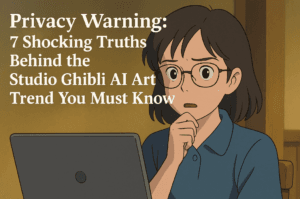Privacy Warning: 7 Shocking Truths Behind the Studio Ghibli AI Art Trend You Must Know
The viral trend of turning selfies into Studio Ghibli-style artwork using AI tools is drawing serious privacy concerns from cybersecurity experts. While the results may look fun and artistic, the real issue lies in how these apps handle user data—often with vague or hidden policies. Experts warn that personal photos, including their metadata like location and device details, can be quietly harvested and repurposed without consent. Despite claims of photo deletion, there’s often no clear explanation of when or how this happens.
Some platforms may even store image fragments that can be used to train AI models for advertising or surveillance. There’s also the risk of data breaches, where leaked images could fuel deepfake creation or identity theft. Security professionals urge users to be cautious, read terms of service, and use tools to strip hidden data before uploading images. Ultimately, what starts as a creative experience may come at the cost of personal privacy—something users need to seriously consider.

Privacy Warning: 7 Shocking Truths Behind the Studio Ghibli AI Art Trend You Must Know
A viral trend allowing users to transform selfies into Studio Ghibli-inspired artwork using AI apps might seem like innocent fun—but cybersecurity experts are sounding the alarm over hidden risks. While these tools create charming animations by merging personal photos with the iconic Studio Ghibli aesthetic, concerns are mounting about how they handle sensitive user data.
How It Works—And Why It’s Risky
These apps rely on advanced algorithms to separate a photo’s content (like faces) from its style, blending them with the whimsical visuals of Ghibli films. However, the process isn’t as harmless as it appears. Many platforms fail to clearly explain what happens to your photos after they’re processed. Some claim images are “deleted immediately,” but experts argue terms like “deletion” can be misleading. Does it mean erased permanently, stored temporarily, or only partially removed? The lack of clarity leaves room for doubt.
Hidden Dangers in Your Photos
Beyond faces, photos often contain metadata—invisible details such as location, timestamps, and device information. Vishal Salvi, a cybersecurity expert, warns that this data can be secretly harvested. “Metadata offers a goldmine of personal information,” he explains, “which could be exploited for targeted ads, surveillance, or even identity theft.”
Another threat is “model inversion” attacks. Hackers could reverse-engineer original images from the AI-stylized versions, potentially exposing users’ unedited photos. Even if companies promise not to store images, fragments of data might linger in their systems. This residual information could be used to train other AI models, including those for advertising or facial recognition—all without user consent.
Why Users Overlook the Risks
Pratim Mukherjee, a cybersecurity engineer, notes that these apps are designed to prioritize engagement over transparency. “They’re fun and intuitive, which distracts users from questioning what they’re agreeing to,” he says. Many apps request access to entire camera rolls, encouraging people to share photos without a second thought. “Creativity is the bait,” Mukherjee adds, “while data collection happens quietly in the background.”
Deepfakes and Identity Theft
Stolen personal data could also fuel deepfakes—realistic fake videos—or identity fraud. Vladislav Tushkanov, an AI researcher, emphasizes that once a photo leaks online or is sold on the dark web, there’s no way to retrieve it. “You can reset a password, but you can’t change your face,” he warns. Even companies with strong security aren’t immune to breaches, putting users’ biometric data at permanent risk.
The Fine Print Problem
Most privacy policies for these apps are lengthy, vague, and filled with jargon. Few users read them before clicking “accept,” unknowingly agreeing to terms that might permit data sharing or indefinite storage. “If a platform doesn’t clearly explain how your data is used or deleted, ask yourself: Is the fun worth the risk?” Mukherjee advises.
How to Protect Yourself
Experts recommend practical steps to stay safe:
- Scrub Metadata: Use tools to strip hidden details from photos before uploading.
- Limit Access: Grant apps permission only to specific photos, not entire galleries.
- Strengthen Security: Enable two-factor authentication and use unique passwords for accounts.
- Research Apps: Check reviews and privacy practices before downloading.
Calls for Regulation
While some countries are tightening AI and data privacy laws, experts argue more needs to be done. Salvi advocates for mandatory privacy certifications and regular audits for AI platforms to ensure compliance. Mukherjee urges governments to require companies to explain data practices in simple, upfront language—not buried in terms of service.
The Bottom Line
While AI-powered art tools offer creative possibilities, they also pose significant privacy threats. As these technologies evolve, users must stay informed and cautious. “Think of your data like personal artwork,” Tushkanov says. “Once you share it, you lose control over where it ends up.” Balancing creativity with caution is key to enjoying these trends safely.
You must be logged in to post a comment.